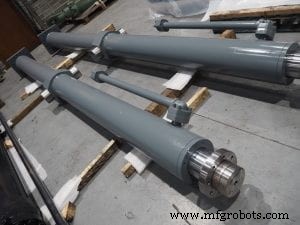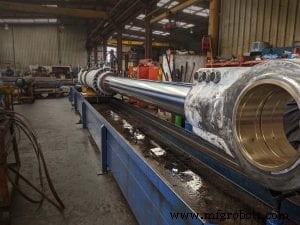Wie groß ist der Hydraulikzylinder, den ich benötige?
Hydraulikzylinder gibt es in allen Formen und Größen, und es kann schwierig sein, herauszufinden, welcher für Ihre Anforderungen der richtige ist. In diesem Artikel führen wir Sie durch die verschiedenen Arten von Hydraulikzylindern, die auf dem Markt erhältlich sind, und erklären, wie Sie den perfekten Zylinder für Ihr Projekt auswählen.
Was ist ein Hydraulikzylinder?
Ein Hydraulikzylinder ist eine Maschine, die ein unter Druck stehendes Fluid verwendet, um ein Objekt zu bewegen. Der Zylinder ist mit Öl und Gas gefüllt, und die unter Druck stehende Flüssigkeit wird verwendet, um den Kolben oder Motor anzutreiben. Die Größe des Zylinders beeinflusst, wie viel Kraft benötigt wird, um das Objekt zu bewegen.
Wenn Sie nach einem Hydraulikzylinder suchen, müssen Sie sich Gedanken über den Verwendungszweck und die Größe des Objekts machen. Die Größe des Objekts bestimmt die Größe des benötigten Hydraulikzylinders. Wenn Sie zum Beispiel einen Hydraulikzylinder verwenden, um ein großes Holzstück zu bewegen, benötigen Sie einen größeren Zylinder als wenn Sie ein kleines Holzstück bewegen.
Die andere Sache, die Sie beim Kauf eines Hydraulikzylinders beachten sollten, ist, wie viel PSI (Pfund pro Quadratzoll) er benötigt. Ein Hydraulikzylinder mit mehr PSI kann stärker drücken als einer mit weniger PSI, benötigt dafür aber auch mehr Energie. Wenn Sie keine Vorstellung davon haben, was Sie brauchen, wenden Sie sich am besten an einen professionellen Installateur oder suchen Sie online nach Bewertungen verschiedener Marken und Modelle.
Was sind die verschiedenen Arten von Hydraulikzylindern?
Wenn es um Hydraulikzylinder geht, gibt es einige verschiedene Arten, denen Sie begegnen könnten. Dies kann von der spezifischen Anwendung abhängen, für die Sie Ihren Zylinder benötigen, daher ist es wichtig, vor dem Kauf zu wissen, um welche Typen es sich handelt.
Kolbenzylinder:Dies sind die gebräuchlichsten Arten von Hydraulikzylindern, und sie arbeiten mit einem Kolben, um die Flüssigkeit zu drücken und zu ziehen. Sie sind normalerweise kleiner, was bedeutet, dass sie effizienter sind, wenn es darum geht, weniger Energie zu verbrauchen.
Spiralzylinder:Diese Zylinder verwenden eine spiralförmige Spule, um den Druck zu erzeugen, und sie sind normalerweise größer als Kolbenzylinder. Dadurch eignen sie sich besser für Hochdruckanwendungen wie das Pumpen von Wasser oder Gas.
Membranzylinder:Diese Zylinder verwenden eine Membran, um den Druck zu erzeugen, und sie werden normalerweise für Anwendungen mit niedrigerem Druck verwendet. Dies liegt daran, dass sie einen größeren Druckbereich haben als andere Arten von Zylindern, was bedeutet, dass sie in mehr Szenarien verwendet werden können.

How big of a hydraulic cylinder do I need
How many pumps can I operate with one hydraulic cylinder?
The size of your hydraulic cylinder will depend on the pumps you want to operate. A common size for a hydraulic cylinder is 50 feet. If you have two pumps, each with a 20-foot reach, then you will need a cylinder that is 80 feet in diameter.
How to calculate the size of your hydraulic cylinder
When purchasing a hydraulic cylinder for your business, you need to calculate the size of the cylinder that will fit your application. There are a few factors to consider when selecting a cylinder size, including the pressure and operating range.
To calculate the required hydraulic cylinder size, you need to first determine the pressure that you need to operate at. The operating range is also important to consider as this will dictate how far the piston can move in either direction. Lastly, you need to factor in the dimensions of your application. For example, if your application requires a cylindrical cylinder with a diameter of 10 inches and a height of 2 inches, then you will need a cylinder with a diameter of 12 inches and a height of 4 inches.
What types of pumps and cylinders do I need?
hydraulic cylinders come in a variety of sizes and can be used for a variety of purposes. Many pumps and cylinders can be used interchangeably, so it is important to understand the specifications of the pump and the cylinder before making a purchase.
When choosing a pump or cylinder, it is important to consider the following factors:
-The application for which the pump or cylinder will be used
-The fluid volume that the pump or cylinder can handle (in liters)
-The pressure that the pump or cylinder can handle (in bar)
-The type of connector that will be used to connect the pump or cylinder to the plumbing system
How does the size of a hydraulic cylinder affect the performance of your project?
When choosing a hydraulic cylinder for your project, you’ll want to make sure that the size of the cylinder will fit the needs of your project. A large hydraulic cylinder can provide more power and torque than a small cylinder, but it may also be more difficult to move and could require more space on your project. Additionally, a large hydraulic cylinder might be more expensive than a smaller one. If you’re not sure what size cylinder you need, consult with a professional contractor or manufacturer.
What are some factors that could change the size of your desired hydraulic cylinder?
When looking to buy a hydraulic cylinder, there are many factors that could affect the size of the cylinder you need. Your application, your desired pressure level and the design of your hydraulic system all play a role in determining the recommended size of the cylinder. Here are some general tips to help you determine what size cylinder is right for you:
-Start by calculating the maximum expected working pressure for your application. This will give you an idea of the necessary force that the cylinder can generate.
-Determine how much pressurized fluid you need to apply. This can be found by multiplying the desired working pressure by the volume of fluid required.
– Use these figures to determine which size hydraulic cylinder is necessary. Determine if you will be using fixed or adjustable heads and select a cylinder accordingly.

How big of a hydraulic cylinder do I need
Comparison of different sizes of hydraulic cylinders
When purchasing a hydraulic cylinder, it is important to consider the application for which it will be used. There are many different sizes of hydraulic cylinders available on the market today, and it can be difficult to decide which one is right for your needs. In this article, we will compare the different sizes of hydraulic cylinders and help you find the best option for your project.
The most common size of hydraulic cylinder is the C-size. This cylinder is often used in construction projects, and it can handle pressures up to 2,000 psi. If you are using a C-size cylinder for industrial applications, it is important to make sure that it has been pressure tested and certified.
If you are looking for a smaller cylinder that can handle lower pressures, the B-sized cylinder is a good option. This cylinder can handle pressures up to 1,500 psi, and it is commonly used in agricultural applications.
If you need a cylinder that can handle higher pressures, the A-sized cylinder is perfect for you. This cylinder can handle pressures up to 10,000 psi, and it is often used in industrial applications. Make sure that you select a A-sized cylinder that has been pressure tested and certified; otherwise,
Schlussfolgerung
If you’re considering buying or building a hydraulic cylinder, be sure to measure the inside diameter of the hole you want to use first. Many hydraulic cylinders are available in both inches and millimeters, so it’s important to know which size is best for your project.
How big of a hydraulic cylinder do I need, please clickhttps://topkitparts.com/ to learn more
Industrielle Ausrüstung
- Auswahl einer hydraulischen Klemme
- Ersetzen eines Hydraulikschlauchs
- Must-Have-Hydraulikzylinder-Reparaturwerkzeuge
- Wie man einen undichten Hydraulikzylinder repariert
- Wie messe ich für die benötigte Hydraulikarmatur?
- wie man eine hydraulische Zahnradpumpe ansaugt
- Wie viel PS braucht eine Hydraulikpumpe?
- Wie testet man eine Hydraulikpumpe?
- Muss meine Hydraulikpumpe repariert werden?
- Funktionsweise einer hydraulischen Zahnradpumpe



